
St Alban's Anglican Church, Newtown, Toowoomba
[Photograph by Trevor Bunning (November 2011)]

St Alban's Anglican Church, Newtown, Toowoomba
[Photograph by Trevor Bunning (November 2011)]
Historical and Technical Documentation by Geoffrey Cox
© OHTA 2011, 2013 (last updated May 2013)
St Alban's Church in Newtown, Toowoomba, was originally part of the parish of St James', but separated in 1994 to become the Toowoomba West parish.1 The present church was opened in February 1909 on the site of a former Sunday School. It was built to the design of the Toowoomba-born architect, William Hodgen. The belfry was added in 1933, and the church was extended in 1958-60 to the design of the Brisbane architects, Messrs Conrad and Gargett. The entire historic timber building was clad in brick veneer in 1982.2
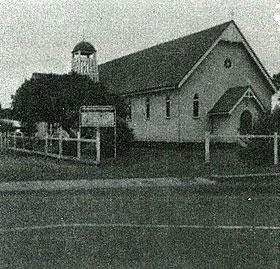
St Alban's Anglican Church, Toowoomba
before the addition of brick cladding
[Photograph from E. Hills, St Alban's Church,
Newtown, Toowoomba, p. 31]
The pipe organ was installed in August 1933, having been built originally by B.B. Whitehouse & Co. of Brisbane for the Scots Presbyterian Church, Clayfield. It was purchased by Whitehouse Bros from Scots Church in June 1933, and sold second-hand to St Alban's for £269.10.0.3 The instrument was dedicated at St Alban's on the afternoon of Sunday 20 August 1933, when Mr Walter Emerson, the church organist and choirmaster, gave the inaugural recital. The choir also sang of this occasion, and Mr Emerson's fine bass voice was reportedly heard to advantage in 'Nearer My God to Thee.'4
No date is given for this instrument in the surviving records of the Whitehouse firm. On the basis of comparison with other organs by the builder, the present author speculatively dated it c.1906 in the Gazetteer of Queensland Pipe Organs (1976),5 and later broadened this to 'between 1904 and 1913' on the basis of other documentation.6 Evidence from contemporary newspapers has since allowed it to be dated to August 1907, when the following notice appeared in The Brisbane Courier:
A pipe-organ by Whitehouse and Co. is at present being built in Scots Church, Bellevue-terrace, Clayfield. It will contain all the latest improvements in organs of its type, and it is said has great sweetness and richness of tone. It is expected to be opened on Wednesday week, 21st instant, by a grand recital, when Mr. Peter Templeton will play the instrument for the first time.7
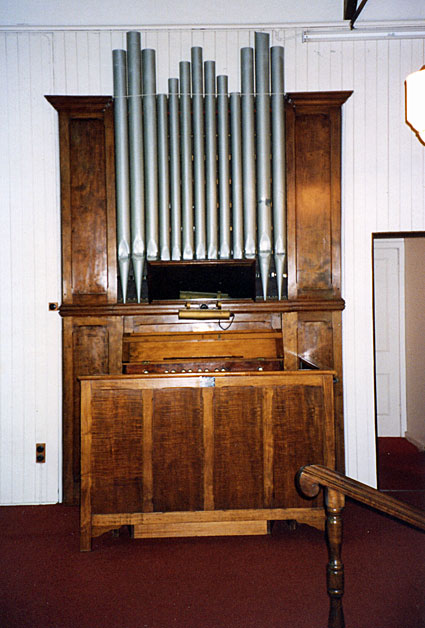
The B.B. Whitehouse & Co. organ of 1907
[Photograph by Howard Baker (1990s)]
This was one of at least five single-manual mechanical-action organs built around this time by B.B. Whitehouse & Co., all including divided manual stops to a greater or lesser extent. Amongst these, no two instruments were identical, although they all had features in common. The present instrument and the slightly smaller one for the Presbyterian Church, Ithaca (now at St Margaret's Anglican Girls' School, Ascot) were the only two in which all of the manual stops were divided (at middle e/f). These two were also similar in that they both had a manual compass of 61 notes, which was unusual at this time. The physical dimensions of the organ and the console appear to have been very similar to the organ built by B.B. Whitehouse & Co. in 1909 for the Presbyterian Church, Toowong, now in somewhat altered form at St Matthew's Anglican Church, Drayton.
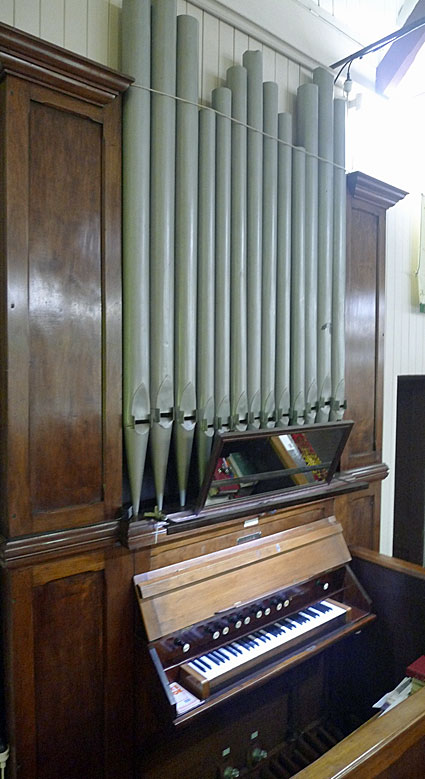
[Photograph by Trevor Bunning (November 2011)]
As for the Ithaca organ, the façade pipes at St Alban's are non-speaking and the manual pipework is entirely enclosed apart from the bottom octave of the Open Diapason 8ft, which is borrowed in this instance from the Pedal Bourdon 16ft. The swell shutters are horizontal. All four stops are here divided into bass and treble halves, splitting at e'/f'. The draw-stops are arranged horizontally in a single row above the keyboard, and bear no pitch indications.
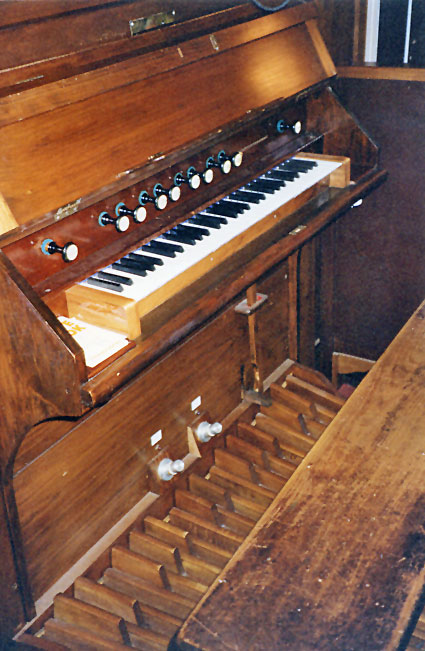
Console of the B.B. Whitehouse & Co. organ
[Photograph by Howard Baker (1990s)]
The organ stood originally in the main body of the church at St Alban's, but was recessed into the new priests' vestry at the time of the 1958-60 extensions to the building, with only the façade and console protruding.8 The instrument was originally hand-blown, and the original blowing handle remains intact. An electric blower was installed around 1937-38.9
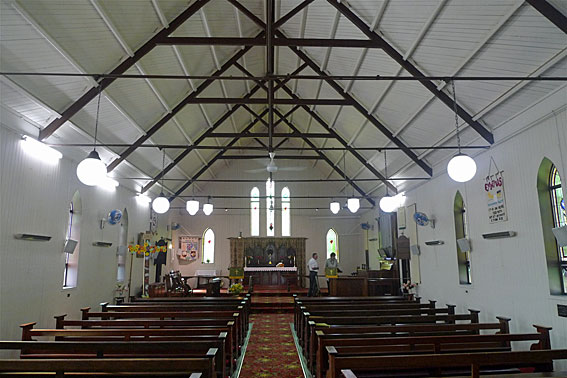
[Photograph by Trevor Bunning (November 2011)]
The action was electrified in the latter part of 1974 by Whitehouse Bros, albeit with minimal alteration to the original mechanism.
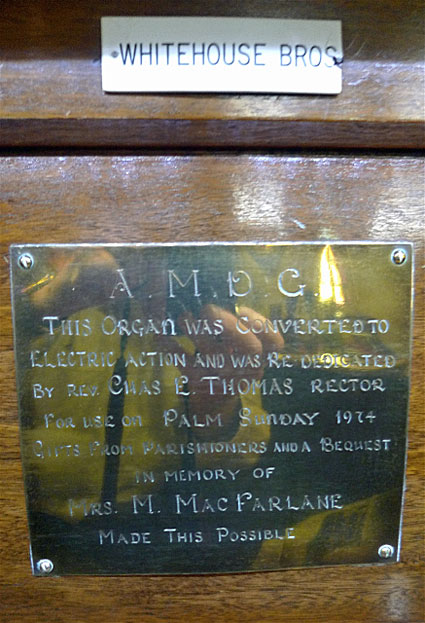
Plaque and organbuilder's nameplate of 1974
[Photograph by Trevor Bunning (November 2011)]
| MANUAL Open Diapason Bass Open Diapason Treble Dulciana Bass [stpd] Dulciana Treble Flute Bass Flute Treble Oboe Bass Oboe Treble PEDAL Bourdon COUPLERS (hitchdown) Manual Octave Manual to Pedal |
[8] [8] [8] [8] [4] [4] [8] [8] [16] |
[bottom octave from Pedal Bourdon] [Ten C] [Ten C] |
Tremulant
Direct electric action (formerly mechanical (with pneumatic off notes)
Compass: 61/30
Hitchdown swell lever
Pedalboard: radiating & concave
Originally handblown
Horizontal wind indicator (above keys).10



Console details
[Photographs by Trevor Bunning (November 2011)]
_________________________________________________________________________
1 Glenda Murrell, Anglican Records and Archive Centre Guide to Records (DioceseofBrisbaneWeb, 2001) - cited January 2004.
2 [Ernest Douglas Hills,] St. Alban's Church, Newtown, Toowoomba: within the Anglican Church of Australia [Toowoomba: St Alban's Parish, 1989], pp. 18-19, 23-31, 33-35; Donald Watson & Judith McKay, Queensland Architects of the 19th Century: A Biographical Dictionary (Brisbane: Queensland Museum, 1994), p. 97.
3 Whitehouse Bros Ledger (1922-1940), pp. 219, 297, 281, 306; Donors List on organ dated 1933-34.
4 Hills, op. cit., pp. 21-23.
5 Geoffrey Cox, Gazetteer of Queensland Pipe Organs (Melbourne: Society of Organists (Vic), 1976.
6 'Organ Ramble to Toowoomba … Historical Notes on the Organs by Geoffrey Cox,' The Organ Voice, vol. 30, no. 3 (September 2003), pp. 9-10; reproduced by David Vann in Organ Australia, vol. 2, no. 1 (March 2007), p. 25.
7 The Brisbane Courier (13 August 1907), p. 3. See also: The Brisbane Courier (19 February 1908), p. 6.
8 Hills, op. cit., pp. 26, 31.
9 Personal communication to G. Cox from Walter Emerson, 1974.
10 Specification noted by G. Cox, February 1974.